
by John Glynn | Jan 15, 2015 | Classic Porsche Blog, Modified Porsche Hot Rods
Swapped some good emails with Jonny, a fellow impact bumper 911 man earlier this week regarding an agreed insurance valuation for his newly-restored Porsche 911 SC. The car is just about finished, so it’s time to make sure that this investment is properly protected in case anything should happen. The car is absolutely lovely: well worth sharing on Ferdinand.
“The brief for the car was an ‘everyday’ hot rod based largely on standard components and some period accessories – hence ‘stock rod’,” says Jonny. “The car as purchased was scruffy but largely sound. The shell needed repair to both kidneys, sills, one inner wing and the oil tank aperture.”
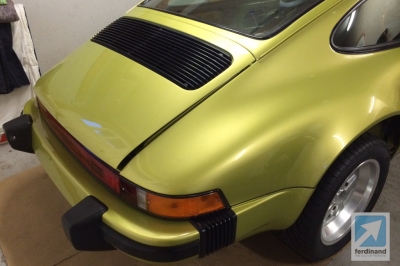
Porsche 911 SC Hot Rod begins
“I contacted well known body man, Barry Carter, about tackling the bodywork. He was at the right end of the country for me and has done some lovely metal restoration on 911s. Barry’s mission was ‘search and destroy’ all rust. After a lot of detailed repair work, I believe this has been accomplished.
“While Barry was working on the rust problem, he also addressed the metalwork in other areas that I was changing, to make the shell perfect. This included a mirror hole delete, side skirt delete, side repeater delete, rear fog light delete, front spoiler delete and rolling the wheel arch edges.
“When the bodywork was done, I stripped the car back to bare metal myself and the shell then went to Steve Utting at DC Coachworks. Steve carried out a complete colour change to Porsche Delphi Green – a 914 colour, similar to some 911 shades. The new paint extends to the wheelarches, engine and luggage bays.
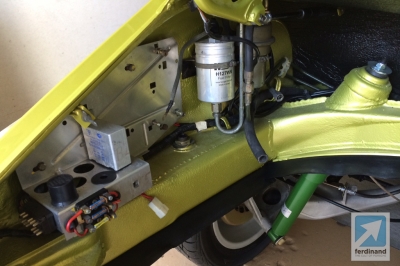
“Former Paragon engine builder, Lee Colbran, rebuilt the engine with standard pistons and cylinders (rebored and Nikasil coated) 964 cams, and SSI heat exchangers. We also backdated the heating: taking the secondary air blower out of the engine compartment. I rebuilt the Bosch K-Jet CIS injection and had the fan and housing refurbed. Mike Bainbridge rebuilt the transmission for me, also fitting a Quaife LSD to the car.
“There’s nothing wrong with standard SC brakes, so no upgrade was necessary. I had the calipers reconditioned by Classic Brake, and replaced every part of the braking system. All the suspension was also removed, stripped and refinished in the correct plating or powerdercoat. New suspension bushes are a mix of standard and Superpro, as this is not a track car. Rear torsion bars went to 26mm, with a 22mm front anti-roll bar. Turbo tie rods were fitted to my 911 SC, as they make a difference.”
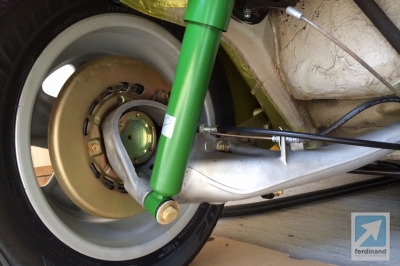
Jonny is an electrical engineer, so there are some clever bits and pieces on the electrical system – more on that in a later post. The interior is very period, with the original brown dash, door caps and trim, some manual Porsche sports seats and very smart Mercedes “Brazil Brown” carpet, as it tones well with the Porsche palette. The door panels and rear quarter trims are covered in “Domino” Alcantara. Rear seat backs have been deleted but the handy “jump seat” cushions are still in place.
Kudos to Jonny for getting in early and snapping up an SC before prices went crazy, then working his way through a detailed “update” restoration so the car can be used every day. Undervalued for far too long, the 3-litre 911s are still my favourite and I love what Jon has done with the Delphi Green stunner. Looking forward to having a drive sometime soon.

by John Glynn | Nov 28, 2014 | Classic Porsche Blog, Modified Porsche Hot Rods, Porsche People
Our friend Thorsten in Germany has shared some cool throwback pics of his early 911 in driver training sessions with a previous owner and a certain Mr Bell. It’s sweet enough to find pics of your car on track in a previous life, but how much more delightful to discover Derek Reginald Bell MBE sitting behind the wheel.
One picture shows the pitlane lineup, where I spied another mate: Bata Mataja, with wife Rosa and his super-cool Porsche 356 race car, Blue Baby. Bata has shared umpteen tales from the Blue Baby archives with Ferdinand, so it was great to send him a previously unseen photo of the car.
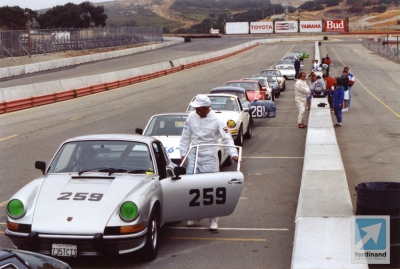
“Running Blue Baby at Laguna would have been very early on in my racing days. I’ll have to think about what club it was with: it may have been a Porsche Club event, but not too sure. Great picture: I think I beat all these guys! 😀 ”
I am also pretty sure these are Porsche Club driving days. Asking Thorsten led to discussions on his car and where it came from – it is a very cool story.
“Well, I was fortunate to find the car I was dreaming to find at Dunkel Brothers in 2003. It looked right and felt even better. The seller was a very nice guy that knew his stuff: he had taken good care of it and it was streets ahead of the other cars I had looked at within my budget.
“A good honest car, we instantly clicked and I have loved my time with it to date. It is tied to many priceless memories: I drove it out in LA for twelve months on Mulholland, at the German Autofest, Palm Springs, getting hooked up with the RGruppe right away.
“Then it came home to Germany and has since done local rallies, trips to Gmünd, drives through France, Belgium, The Netherlands and to Classics at the Castle in England. It’s even been on the proving grounds in Weissach.”
It certainly proves itself in these pics. Thorsten thinks some of the DB shots were taken at Sears Point, but I know this DB pic was taken a few weeks ago at Collier Dade Airfield in Florida, where our Jamie recently worked with Derek again, this time on an official Bentley shoot. A well-matched pair of Porsche fans: the pic still makes me laugh. Perfect!

![Video: Rob Dickinson Singer Porsche Explained]()
by John Glynn | Nov 10, 2014 | Modified Porsche Hot Rods, Porsche People
“It’s not a revolutionary idea; taking an old car and adding some new stuff polishing it up a bit and… ‘tah-dah’. It’s not revolutionary: lots of people have done it, especially in this country with Mustangs and ‘resto mods’ as they’re called over here. I don’t think any company has been crazy enough to do what we’ve attempted to do in such a cross-the-board, spectacularly over-the-top way.”
Whatever about polishing Porsche parts, the likeable Rob Dickinson has certainly polished the rhetoric regarding his Singer 911s since our first meeting, when Jamie Lipman and I were the first guys Rob invited to see his creation, and shoot Singer number 1 on the road in California. Back then, the Singer idea was still forming: what base car, what market, what price?

Rob Dickinson Singer Porsche
Unveiled in 2003, Rob’s Bahama Yellow RGruppe ’69 E hot rod was an inspiration for me, and for many others who followed their hearts to the air-cooled 911. This latest video on Singer eschews the same old Singer shots and lets the organ grinder talk on how his dream has developed. In fairness, the approach could have led to Rob digging a rather large hole for himself, but I think he makes heartfelt sense of his concept and product. Kudos, mon ami.
“Freeman Thomas started this club (RGruppe, with co-founder Cris Huergas) for hot rodded sports purpose early 911s in 2001, so I immediately joined the club when I built my car in 2003, and my car became quite well known in the RGruppe. As I enjoyed being part of this ‘clique’ if you like – this team of guys who had similar tastes – I started to see these expensively executed hot rods.
“My little car was done on the cheap, but a lot of people started to show up to the yearly meetings of the RGruppe in very expensively restored early 911s which had big engines shoehorned into them, and spectacular brakes, and some of these cars were better than others. I happened to drive a particularly well executed version of this car, and was just blown away at how refined and sophisticated an early 911 could actually be.

Steve McQueen references are so important
“That was part of the germination of this idea that these cars don’t have to be rough-and-ready hot rods with limited appeal. The 911 is so evocative – Steve McQueen references are so important for the vibe of this car (and everything that surrounds this car is important) – if someone was to restore a 911 so that it had a wider attractiveness for a wider audience, you could probably appeal to that audience and make a business out of it.
“I started to see that, and the combination of how my car was reacted to in the taste-making world of Los Angeles with the aesthetics, and then I’d got in this car where the engineering had been well sweated, and I thought: put these two together and there’s some fun to be had and maybe some business to be done.
“We generally try and improve every aspect of the car, while honouring everything that is Porsche. We hate custom cars here at this shop. Maybe ‘hate’ is a strong word, but the idea that our car might be seen as a custom car makes me feel nauseous. Our car needs to be seen as a Porsche through and through. We only put Singer badges on our car for the sake of clarity: this is a Porsche 911 that’s been touched by us.
“Hopefully, it’s a line in the sand as to how good an air-cooled 911 can be that isn’t a race car. It’s very easy to build a thinly-disguised race car for the road, but that’s not something we’re too interested in doing. We want to do a properly rounded car which is properly usable, that can be driven to the office on a Monday and driven to the track at the weekend: it has that wonderful duality but just fine-tunes the focus a little bit.”
I have a feeling that the high-end hot rod Rob tips as inspiration is SHTang: the 3.6-litre early 911 built by WEVO for Steven Harris, but I might be wrong. I’ve done many miles in SHTang, but not driven a Singer yet, so can’t tell you how the two compare. That is the obvious next step.
Pics by JamesLipman.com for Car & Driver
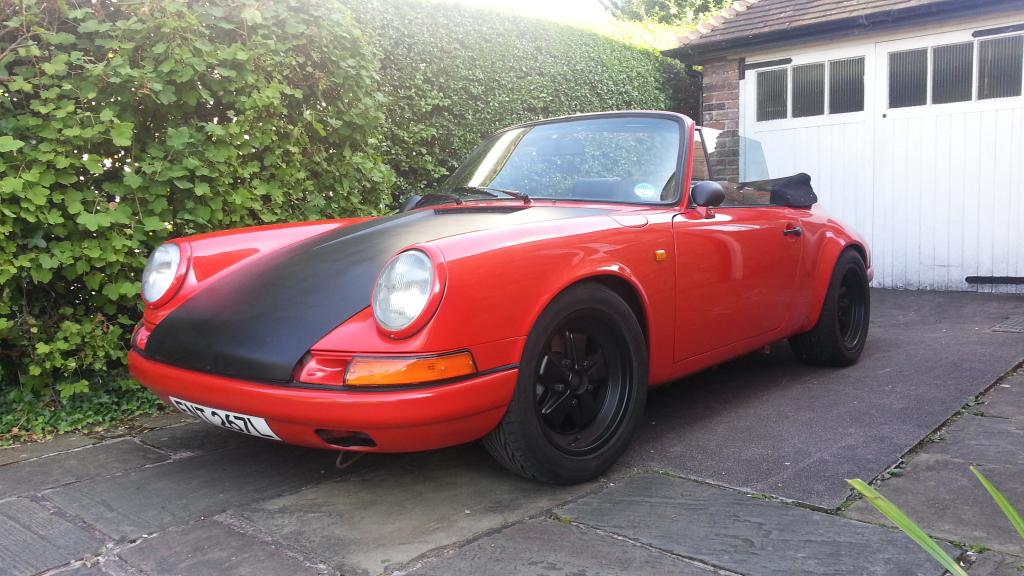
by John Glynn | Sep 21, 2014 | Classic Porsche Blog, Modified Porsche Hot Rods
When the Porsche 911 SC Cabriolet was released to the public in 1982, it was an instant hit. The first fully convertible Porsche for 18 years since the 356 Roadster, build slots sold out and the cars changed hands for well above list price once in the open market.
Based on the 911 SC Targa, which had been the only open-top 911 for many years until the 911 Cabriolet model was developed, SC Cabriolet shells had few changes over the rigid-glass sibling. The main changes were reinforcements to the bottom of the b-posts and changes to the top of the latch panel where the Targa bar would normally sit, replaced by the Cabriolet roof mechanism. The small differences mean that Targa-to-Cabriolet conversions are quite straightforward, and not that rare.
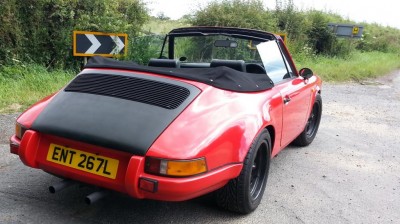
Porsche friend David bought this Porsche 911 SC as a Cabriolet conversion from a 911 SC Targa. “I rescued it from a barn, where it had languished for fifteen years. It came with big bills for new brakes and lots of injection work to get it running but it had a broken headstud or two and some crappy paint.
“It was already non-original (colour, cab conversion, seats, etc) so it was a perfect subject for a bit of hot-rodding – weight loss and backdating being main aims to get a car that (to me) looked good, sounded great, handled well yet was still comfortable enough for a long day in the saddle.

“Having removed or swapped bumpers, front and rear lids, sill covers, stereo, heating, door cards, seats and more I dropped a total of 135kg (~300lbs). This affected the ride height, particularly on new Bilstein Club Sports all round. This had to be sorted, so I was ready for the next step – to re-bush with Polybushes, fit late 3.2 ARBs and sort the ride height and alignment.
“I limped around in it for a few months until biting the bullet for the inevitable engine rebuild. I took the opportunity to remove the heat and go with bare headers. John Holland at Unit 11 did the rebuild, and it works very well. Elsewhere the bodywork is tidy: a few minor issues to look at, but otherwise it’s a strong and solid classic 911.”
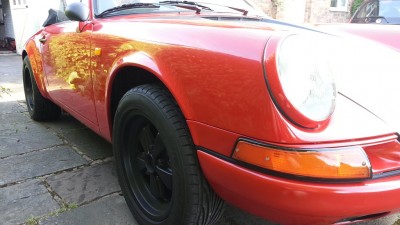
The Cabriolet conversion is less obvious than the other big change over standard: a backdate to early-style front end and bumpers from the solid aluminium impact bumpers. Advantages with the backdate conversion include the lower weight – David estimates he has dropped almost 150 kilograms or about 10% of the Targa’s original weight. It’s the equivalent of two people in the car so quite a lot to lose.
All of the parts to backdate came from our friends at EB Motorsport: bonnet, bumpers and the new wing infill lights, which fix straight to the impact bumper front wings and match to EB front bumpers. The normal fitment involves filling to match the wings but David is a dad on a budget, so has kept it good enough to use and enjoy. To me it is everything you want in a hot rod: 911s are all about driving and this aspect is top of David’s list.
Here’s some video of the car in action: sounds terrific.

by John Glynn | Sep 14, 2014 | Modified Porsche Hot Rods, Project Cars
Caught up with fellow ImpactBumpers.com forum member Alex this week, to discuss an agreed insurance valuation for his Porsche 911. Alex’s car is a 911 3.2 Carrera, but runs a 3.6-litre engine transplant: a 964 engine, rebuilt with some 993RS trickness. The car is light, so performance is “adequate”:

One issue with the 3.6 transplant cars is the exhaust: what do you do with heat and silencer under the rear of an impact-bumper car, a chassis that has less space available than the later models? Alex’s solution is the best I’ve seen yet: all titanium and all home/hand made. Alex explains:
“I liked the first version transplant exhaust on my car: a cheap, simple set up that worked well but with a few limitations that were increasingly bugging me.
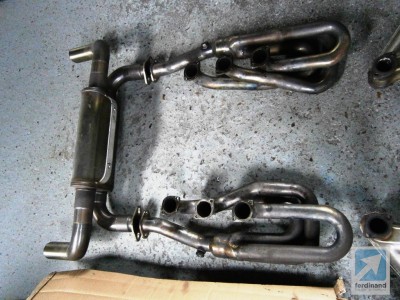
“The first system used reasonably priced 1.75″ dia headers going into a 14” Magnaflow rear box. It sounded great if a little on the noisy side, particularly on a long run, so I made up some inserts, which made it quieter without costing power. This made me wonder why I didn’t just use smaller tubes in the first place.
“The lack of heat, low ground clearance and drone over long journeys sent me back to the drawing board. I decided to follow other transplanters down the 993 heat exchanger route, then build a similar system to 993 Cup cars off the 993 exchangers.
Titanium Exhaust Porsche 911: Akrapovic GT2
“My first system followed a few tuners to through-the-bumper exhaust outlets. I was undecided before doing it, and it was interesting when done, but the novelty wore off. Eventually, finding a titanium Akrapovic exhaust silencer/muffler on eBay from a 997 GT2 sent me down a route I thought would be more in keeping – albeit lots trickier.

“One question was X-pipe or not. Some silencers are x-pipe inside and don’t seem to hurt the 911’s power, but others believed more power would come from a non-X-pipe system. I had already manufactured quite a complex system using the X-pipe idea, but the muffler also had an internal X arrangement so we decided against using two crossovers.

“The first work on version two was to finish my cheapie 993 heat exchangers. With the flanges cut off and jig made, they needed rotating, welding back on and linishing flat. The other side needed patching and a new pipe cobbled together. The steel on these is very thin and although stainless, it’s not the best grade so can corrode.

“Then it was a case of making jigs, which other transplanters were a great help with. Twisting these tight-fitting pipes can be tricky, but a fellow IB’er helped with a fitment guide that worked really well. I bought some more titanium tube, including many bends and had quite a bit prepared by a local water-cutting firm, before my welder friend came around to do the final assembly on the car.
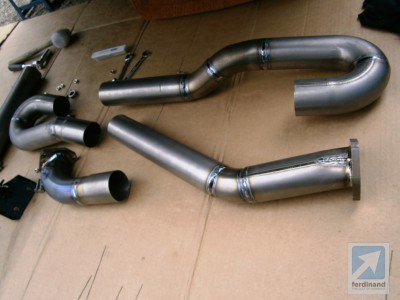
“There’s always a few bits you think I could have done better and there’s still some finishing to do – I may do double slip joints in two places and the tailpipes are just bits of tube at the moment – but it’s on and sounds good. It’s still quite loud, although much quieter than the Magnaflow, but it now has a real rasp to it and makes a racket on overrun.

“With the new exhaust I think the car is now running a bit richer but haven’t done enough miles to really get to know it. Fingers crossed the bumper doesn’t catch fire!”

Awesome work by Alex – so many hours and for sure a pricey system, but if you’re going to think outside the box, then expect some of the costs to live there too. Read more about Alex’s car and many other Porsche 911 hot rods on the Impact Bumper Porsche 911 hot rod forum.

by John Glynn | Aug 22, 2014 | Modified Porsche Hot Rods, Porsche News
The Mexico Blue Porsche 997 GT3 RS 4.0 has just sold at JZM Porsche. Finished in what might be the ultimate paint-to-sample shade, the lack of decals is what most people I spoke to seemed to bring up – that and the price, of course.
For sale at a heady £350,000, people were always going to talk about the advertised price. “That’s not us driving the market,” say the sellers, “that is what the owner decided would convince him to part with it. The last RHD 4.0 RS to sell was a more common white car, which sold at £320k. The market has jumped since then and our customer was happy to keep this low-mileage one-off if his return wasn’t worthwhile.”
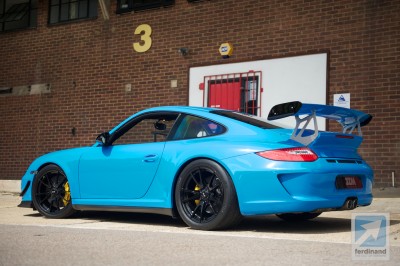
Such is life as a dealer: balancing customer sentiment with market activity. And it’s not always positive. Agressive dealers keen to push the market up for other 911s have dragged others with them, hurting everyone’s prospects as a consequence. One particular specialist known for scary prices has been listing 911 Turbos – mainly 993s – at huge money this year, forcing other sellers to list cars beyond their comfort zone, to prevent more realistic prices from inferring poor condition. I’m not saying dealers are scared of pushing prices, but there’s a fine line between market top and madness.

JZM has since re-priced its low-mileage Porsche 993 Turbo to what it believes is a more realistic level. Further down the price scale, I’ve spoken to a number of other dealer friends this week who, fed up with silly prices for projects, have been bidding much lower then the asking price and not coming home empty-handed.

One dealer who recently inspected a 1970 911 for a customer valued the car at just 60% of asking. “It was up for one price but with non-matching numbers, rust to repair and no shortage of issues to point at, I offered much less than the advertised price and told him to try and do better. A few days later, the phone rang to say come pick it up.”

What would a potentially slowing project market prove? Not much we don’t know. Prices for good cars are one place, prices for projects are somewhere else entirely. Few people want to buy huge amounts of work as most specialist repairers are pretty booked up, and restoration prices are climbing as parts get harder to source. At some stage there may be a tipping point: if it comes, I’m assuming it will be interest rate related.
There’s no harm in sellers making hay while they can if that what the market is willing to pay. Hurts that genuine enthusiasts are being blown out by investors, but let’s see how it all plays out.

































